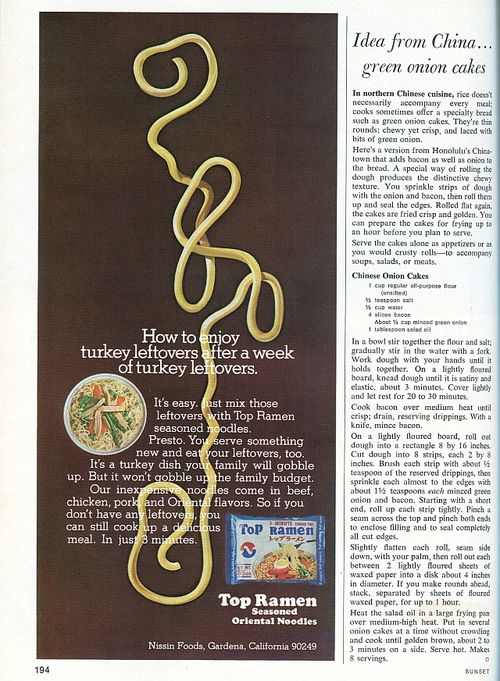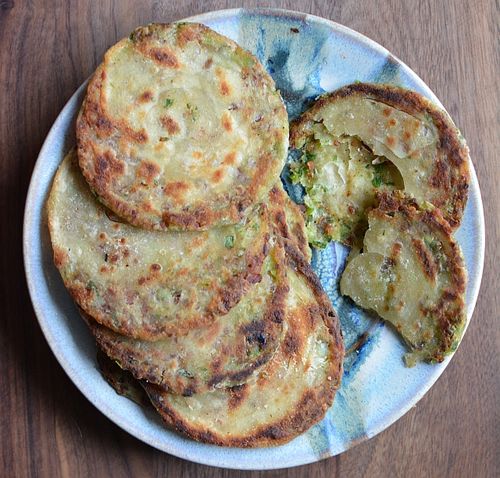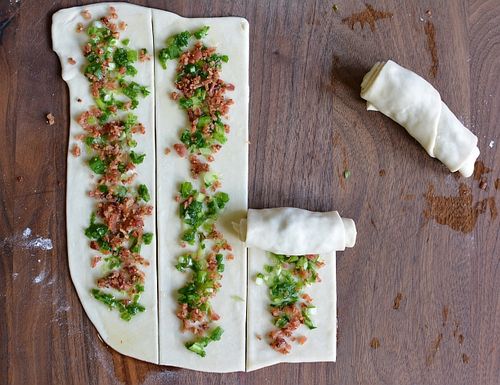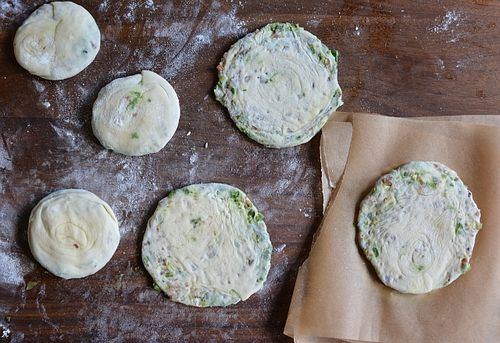A good recipe should stand the test of time. This one is from the November 1973 issue of Sunset magazine. I receive the issue after going to a special luncheon at Sunset to honor the incredible career of its storied food editor, Jerry Anne Di Vecchio. She had created the position and held it for 50 years, impacting what people all over the western United States cooked.
The magazine informed and inspired cooks to develop a multicultural perspective on food because there was diversity in the American West. Sunset ran a lot of Asian recipes. Asian have historically settled in large numbers in the region and cultural ties across the Pacific run deep. On staff at Sunset for decades was Linda Lau Anusasanan, who eventually wrote The Hakka Cookbook, a wonderful work full of insights about Hakka Chinese people and their recipes.
At the Les Dames d'Escoffier luncheon, we each received complimentary vintage issues, and when I began flipping through the one I got, the first page I landed on contained a recipe for “Chinese onion cakes”. Nowadays, they're called Chinese green onion or Chinese scallion pancakes, a savory snack, sometimes found on dim sum menus. They’re part of the vast family of Chinese bing –-cakes, dumplings, pancakes and other doughy morsels, which developed over 2000 years ago. It's an ancient food.


The 1973 recipe included nuanced cultural information on Chinese foodways and I imagine that Linda wrote the recipe; she traveled to China on behalf of the Sunset, reported on Asian foodways in America, and wrote many Asian recipes in the magazine. The recipe introduction said that the bacon was an addition made by cooks in Honolulu’s Chinatown. How would the recipe perform over 40 years later?
Pretty well because the ingredients list is really short. (Less to go wrong or change.) One thing that was somewhat different is that it called for four slices of bacon. When I stood up my butcher counter looking at the bacon, I thought four slices was a lot.
Twenty-first century bacon tends to be cut as very thick, long pieces. My family came to the U.S. in 1975 and I recall that bacon in those days was very thinly cut and in relatively short lengths. Remember Farmer John and Hormel bacon? Sizzlean? Instead of four, I ended up using three pieces. Pancakes like these do not require much filling. It’s thrifty food.
Instead of making the dough by hand as the recipe directed, I used a food processor and cut down my work by probably 80 percent. The dough turned out satiny as described and I used supermarket Gold Medal all-purpose flour, though next time, I may try more tender Whole Foods organic all-purpose. I was able to roll the dough out pretty well too.
Filling and cooking the pancakes was easy-- the on-point instructions were extremely detailed. Jerry explained that Sunset magazine used to invite home cooks into their kitchens to test drive the recipes. Then they would tweak the recipes to make sure that home cooks would succeed. That is a luxury in today’s magazine publishing world where budgets have considerably shrunk. As a cookbook writer, I have my recipes tested by a group of curious and dedicated cooks. They kick my butt and help me make a solid cookbook.
When the bacon and pancakes were done, I ate one at room temperature. It was good but not great. Rory noted the recipe instructions, which said to serve them hot. So I reheated them in a skillet and serve them with hot and sour soup. The pancakes were great. Not too greasy, crisp and chewy, with good flavor. It was and remains a marvelous "Idea from China..."
RECIPE
Bacon and Scallion Pancakes
Yields 8 pancakes to serve 4
Ingredients
- 1 cup (5 oz / 142 g) unbleached all-purpose flour
- ½ teaspoon salt
- ⅓ cup (90 ml) lukewarm water
- 3 ounces (90 g) sliced bacon (2 or 3 slices)
- ¼ cup (60 ml) minced green onion, white and green parts
- 1 to 2 tablespoons canola or other neutral oil
Instructions
- Put the flour and salt in the bowl of a food processor. Remove the feed tube pusher. With the machine running slowly pour the water through the feed tube. Stop the machine when a ball of dough forms around the metal blade with a few scraggly pieces lingering in the bowl.
- Transfer the dough to a very lightly floured work surface and knead into a satiny smooth ball. Loosely cover with plastic wrap and set aside for 20 to 30 minutes, or even up to 2 hours.
- Cook the bacon in a skillet over medium heat until crisp; as needed, pour off the bacon drippings that into a small bowl to facilitate crisping. Save the drippings. Set the cooked bacon on paper towel to cool, then mince by hand or in the processor. Set aside with the green onion and drippings.
- To make the pancakes, lightly flour your work surface then roll the dough into a rectangle measuring 8 by 16 inches (20 by 40 cm). Cut the dough into 8 strips, each one measuring 2 by 8 inches (5 by 20 cm).
- Brush each strip with ½ teaspoon of the reserve bacon drippings, then sprinkle each strip with 1 ½ teaspoons of each of the minced green onion and bacon. Sprinkle the toppings to nearly the edge of each dough strip.
- Starting with the short end of the nose strip, roll of each does strip jellyroll style, nice and tight. Press to seal across the top and press both ends to enclose the filling. Do your best to completely seal all cut edges.
- Stand each one, rolled edge side down, then slightly flattened with your palm into a disk. Flour your work surface, then roll each disk into a 4-inch (10 cm) circle, flouring the dough as you work to prevent sticking. When bits bust through the dough, flour the disk to keep the bits in place. When making these ahead, keep them in between floured pieces of parchment paper in a stack; loosely cover with plastic wrap and let sit at room temperature for up to 1 hour.
- To cook, use a large skillet and add about 1 ½ to 2 teaspoons of oil (use leftover bacon drippings). Heat over medium or medium-high heat then cook the pancakes 4 at time for about 2 minutes on each side, until golden brown; as needed, drizzle a little bit extra oil into the pan to facilitate cooking and prevent a dry finish. Regulate the heat to cook evenly. When done, gently reheat cooled ones over medium or medium-low heat to serve hot.
Adapted from: Sunset Magazine, November 1973
Related posts and links:



















